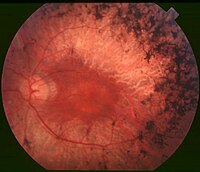
Photo from wikipedia
ABSTRACT This study quantified the performance progression and variability of elite 100 m freestyle para swimmers according to classification and medal status. To depict progression, annual world ranking times from 2009… Click to show full abstract
ABSTRACT This study quantified the performance progression and variability of elite 100 m freestyle para swimmers according to classification and medal status. To depict progression, annual world ranking times from 2009 to 2016 were obtained for 253 male and 236 female para swimmers and expressed relative to their respective (2012 & 2016) Paralympic Games performances. Comparisons according to medalling status and para classification were made using linear mixed models. Although not always continuous, swimmers generally progressed year-on-year by≈0.53%. Medallists made significantly greater performance progressions (2.76 ± 0.63%) than non-medallists (2.15 ± 0.31%) over the years preceding a Paralympic Games. The most physically impaired swimmers (S1-S4 classes) made significantly greater performance progressions in the final 3 years before a Paralympic Games than all other subgroups (S5-S6, S7-S10 & S11-S13). Within-swimmer variation in swimmers overall, expressed as coefficient of variation, was 0.56 ± 0.39%, whilst between-swimmer variation was 0.9 ± 0.2%. In both scenarios, S1-S4 swimmers evidenced greater overall variation. These findings have implications for para swimmers, coaches and support staff when planning training and analysing competition outcomes. We also propose performance variation to be a useful metric in the identification of para swimmers warranting (re-)classification.
Journal Title: Journal of Sports Sciences
Year Published: 2023
Link to full text (if available)
Share on Social Media: Sign Up to like & get
recommendations!